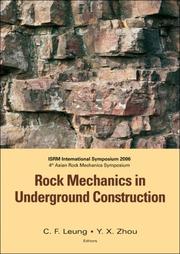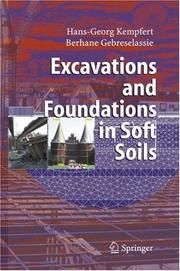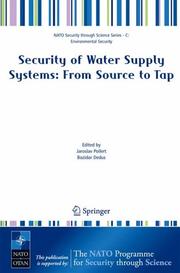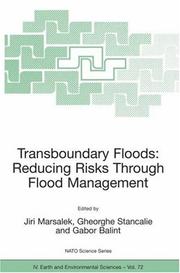| Listing 1 - 10 of 12 | << page >> |
Sort by
|

ISBN: 1281373273 9786611373276 9812772413 9789812772411 9781281373274 9789812704375 981270437X 6611373276 Year: 2006 Publisher: Hackensack, NJ World Scientific Pub. Co.
Abstract | Keywords | Export | Availability | Bookmark
 Loading...
Loading...Choose an application
- Reference Manager
- EndNote
- RefWorks (Direct export to RefWorks)
Draws on rock mechanics and engineering with contributors from all over Asia and many other parts of the world. This title covers a range of rock mechanics and engineering topics such as: rock tunnels, caverns, mining, rock slopes and dams, rock blasting, and more. It also includes rock engineering case studies.
Mining engineering --- Rock mechanics --- Underground construction
Book

ISBN: 0784478171 Year: 2006 Publisher: American Society of Civil Engineers
Abstract | Keywords | Export | Availability | Bookmark
 Loading...
Loading...Choose an application
- Reference Manager
- EndNote
- RefWorks (Direct export to RefWorks)
Proceedings of sessions of the GeoShanghai Conference, held in Shanghai, China, June 6-8, 2006. Hosted by Shanghai Society of Civil Engineering, China. In cooperation with the Geo-Institute of ASCE; Georgia Institute of Technology; and University of Kansas. This Geotechnical Special Publication contains 52 technical papers and presents the recent advances in research and practical applications in engineering issues in karst and ground subsidence, tunneling and underground construction, and deep excavation. The book begins with two keynote papers by Professor Linda Yang and Professor Jian Zhao, which summarize recent advances in some key problems on stability analysis of underground rock structures and recent studies of rock dynamics for underground development, respectively. The section on engineering issues in karst and ground subsidence addresses investigation, construction and design issues in karst terrain and ground subsidence due to withdrawal of fluids. The tunneling and underground construction section covers topics such as box culverts, shield tunnels and interactions between tunnels and other underground and surface structures. The deep excavation section presents theoretical and case studies on stability and deformations associated with deep excavation.
Engineering geology --- Underground construction --- Underground construction --- Underground structures --- Ground motion --- Karst --- Land subsidence --- Excavation --- Tunneling --- Faculty --- Underground construction --- Underground structures --- Ground motion --- Karst --- Land subsidence --- Excavation --- Tunneling --- Faculty
Book
Year: 2006 Publisher: [Place of publication not identified] American Society of Civil Engineers
Abstract | Keywords | Export | Availability | Bookmark
 Loading...
Loading...Choose an application
- Reference Manager
- EndNote
- RefWorks (Direct export to RefWorks)
Proceedings of the 10th International Conference on Shotcrete for Underground Support, held in Whistler, British Columbia, September 12-16, 2006. The collection contains 31 papers that cover subjects ranging from a review of the latest guides, standards, specifications, and test methods for shotcrete for underground support to case history examples of new developments in shotcrete in tunnels and mines. The papers provide guidance on the production of technically sound, durable, economical, and safe shotcrete in the underground environment.
Underground construction --- Shotcrete --- Civil & Environmental Engineering --- Engineering & Applied Sciences --- Civil Engineering --- Shotcrete --- Case studies --- Standards and codes --- Material tests --- Underground structures --- Tunnels --- Material durability --- Economic factors --- Shotcrete --- Case studies --- Standards and codes --- Material tests --- Underground structures --- Tunnels --- Material durability --- Economic factors
Book
ISBN: 1280624035 9786610624034 3540331611 Year: 2006 Publisher: Berlin ; New York : Springer,
Abstract | Keywords | Export | Availability | Bookmark
 Loading...
Loading...Choose an application
- Reference Manager
- EndNote
- RefWorks (Direct export to RefWorks)
Presents the statistical knowledge and methodology of sampling and data analysis useful for spatial inventory and monitoring of natural resources. This work places emphasis on how statistical methodology can be employed and embedded in real-life spatial inventory and monitoring projects.
Environmental sampling --- Environmental monitoring --- Natural resources --- Statistical methods. --- Management. --- Resource management (Natural resources) --- Resources management (Natural resources) --- Biomonitoring (Ecology) --- Ecological monitoring --- Environmental quality --- Monitoring, Environmental --- Applied ecology --- Environmental engineering --- Pollution --- Sampling --- Measurement --- Monitoring --- Environmental toxicology. --- Hydraulic engineering. --- Environmental sciences. --- Analytical biochemistry. --- Ecology. --- Ecotoxicology. --- Geotechnical Engineering & Applied Earth Sciences. --- Geoengineering, Foundations, Hydraulics. --- Math. Appl. in Environmental Science. --- Analytical Chemistry. --- Balance of nature --- Biology --- Bionomics --- Ecological processes --- Ecological science --- Ecological sciences --- Environment --- Environmental biology --- Oecology --- Environmental sciences --- Population biology --- Analytic biochemistry --- Biochemistry --- Chemistry, Analytic --- Environmental science --- Science --- Engineering, Hydraulic --- Engineering --- Fluid mechanics --- Hydraulics --- Shore protection --- Ecotoxicology --- Pollutants --- Environmental health --- Toxicology --- Ecology --- Geotechnical engineering. --- Engineering geology. --- Engineering—Geology. --- Foundations. --- Hydraulics. --- Analytical chemistry. --- Ecology . --- Engineering, Geotechnical --- Geotechnics --- Geotechnology --- Engineering geology --- Analysis, Chemical --- Analytical chemistry --- Chemical analysis --- Metallurgical analysis --- Mineralogy, Determinative --- Flow of water --- Water --- Hydraulic engineering --- Jets --- Architecture --- Building --- Structural engineering --- Underground construction --- Caissons --- Earthwork --- Masonry --- Soil consolidation --- Soil mechanics --- Walls --- Civil engineering --- Geology, Economic --- Flow --- Distribution --- Details --- Geology --- Geology. --- Analytic chemistry --- Chemistry

ISBN: 1280625929 9786610625925 3540328955 3540328947 3642069444 Year: 2006 Publisher: Berlin : Springer-Verlag,
Abstract | Keywords | Export | Availability | Bookmark
 Loading...
Loading...Choose an application
- Reference Manager
- EndNote
- RefWorks (Direct export to RefWorks)
The book is about soft soil engineering and is intended to serve the practicing as well as the research engineers. The planning, design and construction of excavations and foundations in soft to very soft soils is always a difficult and challenging assignment to engineers. The authors have tried to address some of these problems and challenges in this book. Beside the state of the art of soft soils, authors own research results and experiences from practical projects are presented in the book. Special emphasis is also given among others on the presentation of several case studies corresponding to each topic treated in the book as well as a summary of the experiences in the - termination of soil parameters for finite element analysis of geotechnical problems. The book is illustrated by a wealth of photographs and diagrams. The reader is referred to chapter 1 for a general introduction to the content of the book, the motives and backgrounds of the book. The aim of the authors is to give the readers an overview of the state of the art of material properties of soft soils and their application in excavations, different types of foundations and stabilization methods. The authors emphasis, however, that the presence of soft soil in connection with construction measure should not a priori be classified as extremely difficult and strong cost intensive for the project.
Soil mechanics. --- Soil stabilization. --- Excavation. --- Foundations. --- Architecture --- Building --- Structural engineering --- Underground construction --- Caissons --- Earthwork --- Masonry --- Soil consolidation --- Soil mechanics --- Walls --- Details --- Civil engineering --- Tunneling --- Stabilization of soils --- Stability --- Reinforced soils --- Slopes (Soil mechanics) --- Soil compaction --- Subsurface drainage --- Soil engineering --- Soils --- Soils (Engineering) --- Geotechnical engineering --- Mechanics --- Foundations --- Soil physics --- Civil engineering. --- Hydraulic engineering. --- Soil conservation. --- Building Construction and Design. --- Civil Engineering. --- Geotechnical Engineering & Applied Earth Sciences. --- Geoengineering, Foundations, Hydraulics. --- Soil Science & Conservation. --- Conservation of soil --- Erosion control, Soil --- Soil erosion --- Soil erosion control --- Agricultural conservation --- Soil management --- Engineering, Hydraulic --- Engineering --- Fluid mechanics --- Hydraulics --- Shore protection --- Public works --- Control --- Prevention --- Conservation --- Buildings—Design and construction. --- Building. --- Construction. --- Engineering, Architectural. --- Geotechnical engineering. --- Engineering geology. --- Engineering—Geology. --- Hydraulics. --- Soil science. --- Pedology (Soil science) --- Agriculture --- Earth sciences --- Flow of water --- Water --- Hydraulic engineering --- Jets --- Geology, Economic --- Engineering, Geotechnical --- Geotechnics --- Geotechnology --- Engineering geology --- Architectural engineering --- Buildings --- Construction --- Construction science --- Engineering, Architectural --- Structural design --- Construction industry --- Flow --- Distribution --- Geology --- Design and construction
Book
ISBN: 1281116734 9786611116736 0817644598 Year: 2006 Publisher: Boston : Birkhauser,
Abstract | Keywords | Export | Availability | Bookmark
 Loading...
Loading...Choose an application
- Reference Manager
- EndNote
- RefWorks (Direct export to RefWorks)
Increasingly, neural networks are used and implemented in a wide range of fields and have become useful tools in probabilistic analysis and prediction theory. This book—unique in the literature—studies the application of neural networks to the analysis of time series of sea data, namely significant wave heights and sea levels. The particular problem examined as a starting point is the reconstruction of missing data, a general problem that appears in many cases of data analysis. Specific topics covered include: * Presentation of general information on the phenomenology of waves and tides, as well as related technical details of various measuring processes used in the study * Description of the model of wind waves (WAM) used to determine the spectral function of waves and predict the behavior of SWH (significant wave heights); a comparison is made of the reconstruction of SWH time series obtained by means of neural network algorithms versus SWH computed by WAM * Principles of artificial neural networks, approximation theory, and extreme-value theory necessary to understand the main applications of the book * Application of artificial neural networks (ANN) to reconstruct SWH and sea levels (SL) * Comparison of the ANN approach and the approximation operator approach, displaying the advantages of ANN * Examination of extreme-event analysis applied to the time series of sea data in specific locations * Generalizations of ANN to treat analogous problems for other types of phenomena and data This book, a careful blend of theory and applications, is an excellent introduction to the use of ANN, which may encourage readers to try analogous approaches in other important application areas. Researchers, practitioners, and advanced graduate students in neural networks, hydraulic and marine engineering, prediction theory, and data analysis will benefit from the results and novel ideas presented in this useful resource.
Oceanography --- Time-series analysis. --- Neural networks (Computer science) --- Statistical methods. --- Artificial neural networks --- Nets, Neural (Computer science) --- Networks, Neural (Computer science) --- Neural nets (Computer science) --- Artificial intelligence --- Natural computation --- Soft computing --- Analysis of time series --- Autocorrelation (Statistics) --- Harmonic analysis --- Mathematical statistics --- Probabilities --- Oceanography, Physical --- Oceanology --- Physical oceanography --- Thalassography --- Earth sciences --- Marine sciences --- Ocean --- Hydraulic engineering. --- Distribution (Probability theory. --- Mathematical statistics. --- Geoengineering, Foundations, Hydraulics. --- Probability Theory and Stochastic Processes. --- Statistical Theory and Methods. --- Engineering Fluid Dynamics. --- Complex Systems. --- Mathematical Modeling and Industrial Mathematics. --- Distribution functions --- Frequency distribution --- Characteristic functions --- Engineering, Hydraulic --- Engineering --- Fluid mechanics --- Hydraulics --- Shore protection --- Mathematics --- Statistical inference --- Statistics, Mathematical --- Statistics --- Sampling (Statistics) --- Statistical methods --- Engineering geology. --- Engineering—Geology. --- Foundations. --- Hydraulics. --- Probabilities. --- Statistics . --- Fluid mechanics. --- Statistical physics. --- Dynamical systems. --- Mathematical models. --- Models, Mathematical --- Simulation methods --- Dynamical systems --- Kinetics --- Mechanics, Analytic --- Force and energy --- Mechanics --- Physics --- Statics --- Hydromechanics --- Continuum mechanics --- Statistical analysis --- Statistical data --- Statistical science --- Econometrics --- Probability --- Combinations --- Chance --- Least squares --- Risk --- Flow of water --- Water --- Hydraulic engineering --- Jets --- Architecture --- Building --- Structural engineering --- Underground construction --- Caissons --- Earthwork --- Masonry --- Soil consolidation --- Soil mechanics --- Walls --- Civil engineering --- Geology, Economic --- Flow --- Distribution --- Details --- Geology

ISBN: 1280461292 9786610461295 1402045646 140204562X 1402045638 Year: 2006 Publisher: Dordrecht, Netherlands : Springer,
Abstract | Keywords | Export | Availability | Bookmark
 Loading...
Loading...Choose an application
- Reference Manager
- EndNote
- RefWorks (Direct export to RefWorks)
The provision of safe drinking water is one of the primary responsibilities of all governments, which address and share this responsibility through various levels of administration, ranging from the municipal to federal level, and further sharing of such responsibilities with public or private water utility companies. Recent reviews indicate the existence of significant vulnerabilities of all components of the infrastructure in general, among which the water supply systems are considered the most critical because of it’s importance to human life. Indeed, such systems encompass huge number of structures, plants and devices that might become a target of sabotage, and they all may be found in major components of each water supply system: the raw water sources (usually a reservoir, a river intake, or groundwater aquifer), water purification plants (encompassing various treatment processes), and water distribution networks bringing potable water to the consumers. Consequently, the reality of the post-September 11 situation forces the operators of water supply systems through the world to examine the security and safety of their systems, it’s vulnerability to intentional interference and sabotage with respect to quantity and quality of potable water. In assessing the system vulnerability, there is an urgent need to develop emergency response plans providing ways and means for alternative water supply for the moment of system operation disruption, and system remediation and recovery after the attack.
Water-supply --- Security measures --- Health aspects --- Environmental aspects --- Management --- Availability, Water --- Water availability --- Water resources --- Natural resources --- Public utilities --- Water resources development --- Water utilities --- Environmental pollution. --- Hydraulic engineering. --- Waste Water Technology / Water Pollution Control / Water Management / Aquatic Pollution. --- Water Industry/Water Technologies. --- Hydrogeology. --- Geoengineering, Foundations, Hydraulics. --- Engineering, Hydraulic --- Engineering --- Fluid mechanics --- Hydraulics --- Shore protection --- Chemical pollution --- Chemicals --- Contamination of environment --- Environmental pollution --- Pollution --- Contamination (Technology) --- Asbestos abatement --- Bioremediation --- Environmental engineering --- Environmental quality --- Factory and trade waste --- Hazardous waste site remediation --- Hazardous wastes --- In situ remediation --- Lead abatement --- Pollutants --- Refuse and refuse disposal --- Water pollution. --- Water-supply. --- Engineering geology. --- Engineering—Geology. --- Foundations. --- Hydraulics. --- Flow of water --- Water --- Hydraulic engineering --- Jets --- Architecture --- Building --- Structural engineering --- Underground construction --- Caissons --- Earthwork --- Masonry --- Soil consolidation --- Soil mechanics --- Walls --- Civil engineering --- Geology, Economic --- Geohydrology --- Geology --- Hydrology --- Groundwater --- Aquatic pollution --- Fresh water --- Fresh water pollution --- Freshwater pollution --- Inland water pollution --- Lake pollution --- Lakes --- Reservoirs --- River pollution --- Rivers --- Stream pollution --- Water contamination --- Water pollutants --- Water pollution --- Waste disposal in rivers, lakes, etc. --- Flow --- Distribution --- Details
Book
ISBN: 3540293876 Year: 2006 Publisher: Berlin ; New York : Springer,
Abstract | Keywords | Export | Availability | Bookmark
 Loading...
Loading...Choose an application
- Reference Manager
- EndNote
- RefWorks (Direct export to RefWorks)
Geophysical techniques can map the underground conditions apart from boreholes. The use of these methods for hydrogeological applications is demonstrated for mapping of porous and structural aquifers, determination of groundwater quality (mineralization), assessment of hydraulic properties, determination of aquifer vulnerability and mapping of contaminated sites. Additionally, a description of geophysical techniques used for groundwater studies is given including seismics, resistivity methods, magnetics, ground penetrating radar and NMR (nuclear magnetic resonance). In this second edition new chapters on RMT (radio magnetotelluric) and on the determination of groundwater flow in monitoring wells are included.
Hydrogeology. --- Geophysics. --- Groundwater. --- Geological mapping. --- Geological physics --- Terrestrial physics --- Earth sciences --- Physics --- Geohydrology --- Geology --- Hydrology --- Groundwater --- Geologic mapping --- Cartography --- Ground water --- Subterranean water --- Underground water --- Water, Underground --- Water --- Hydrogeology --- Physical geography. --- Hydraulic engineering. --- Environmental pollution. --- Waste disposal. --- Geophysics/Geodesy. --- Waste Water Technology / Water Pollution Control / Water Management / Aquatic Pollution. --- Waste Management/Waste Technology. --- Geotechnical Engineering & Applied Earth Sciences. --- Geoengineering, Foundations, Hydraulics. --- Chemical pollution --- Chemicals --- Contamination of environment --- Environmental pollution --- Pollution --- Contamination (Technology) --- Asbestos abatement --- Bioremediation --- Environmental engineering --- Environmental quality --- Factory and trade waste --- Hazardous waste site remediation --- Hazardous wastes --- In situ remediation --- Lead abatement --- Pollutants --- Refuse and refuse disposal --- Engineering, Hydraulic --- Engineering --- Fluid mechanics --- Hydraulics --- Shore protection --- Geography --- Environmental aspects --- Water pollution. --- Waste management. --- Geotechnical engineering. --- Engineering geology. --- Engineering—Geology. --- Foundations. --- Hydraulics. --- Civil engineering --- Geology, Economic --- Engineering, Geotechnical --- Geotechnics --- Geotechnology --- Engineering geology --- Aquatic pollution --- Fresh water --- Fresh water pollution --- Freshwater pollution --- Inland water pollution --- Lake pollution --- Lakes --- Reservoirs --- River pollution --- Rivers --- Stream pollution --- Water contamination --- Water pollutants --- Water pollution --- Waste disposal in rivers, lakes, etc. --- Flow of water --- Hydraulic engineering --- Jets --- Architecture --- Building --- Structural engineering --- Underground construction --- Caissons --- Earthwork --- Masonry --- Soil consolidation --- Soil mechanics --- Walls --- Flow --- Distribution --- Details
Book
ISBN: 1280611375 9786610611379 1402036558 Year: 2006 Publisher: Dordrecht : Springer,
Abstract | Keywords | Export | Availability | Bookmark
 Loading...
Loading...Choose an application
- Reference Manager
- EndNote
- RefWorks (Direct export to RefWorks)
Discusses the social, economic, and environmental problems in twelve Asia Pacific mega-harbors: Tokyo Bay, the Pearl Estuary, Hong Kong, Shanghai and the Yangtze Delta, Klang, Manila Bay, Jakarta Bay, Pearl Harbor, Ho Chi Minh City, Bankok and the upper gulf of Thailand, Singapore, and Darwin.
Harbors --- Environmental degradation --- Urbanization --- Environmental aspects --- Pacific Coast (Asia) --- Environmental conditions. --- Cities and towns, Movement to --- Urban development --- Urban systems --- Cities and towns --- Social history --- Sociology, Rural --- Sociology, Urban --- Urban policy --- Rural-urban migration --- Degradation, Environmental --- Destruction, Environmental --- Deterioration, Environmental --- Environmental destruction --- Environmental deterioration --- Natural disasters --- Environmental quality --- Harbours --- Ports --- Seaports --- Channels (Hydraulic engineering) --- Hydraulic structures --- Terminals (Transportation) --- Applied Ecology. --- Hydraulic engineering. --- Ecology. --- Oceanography. --- Physical geography. --- Aquatic biology. --- Geoengineering, Foundations, Hydraulics. --- Physical Geography. --- Freshwater & Marine Ecology. --- Hydrobiology --- Water biology --- Aquatic sciences --- Biology --- Geography --- Oceanography, Physical --- Oceanology --- Physical oceanography --- Thalassography --- Earth sciences --- Marine sciences --- Ocean --- Balance of nature --- Bionomics --- Ecological processes --- Ecological science --- Ecological sciences --- Environment --- Environmental biology --- Oecology --- Environmental sciences --- Population biology --- Engineering, Hydraulic --- Engineering --- Fluid mechanics --- Hydraulics --- Shore protection --- Ecology --- Environmental protection --- Nature conservation --- Applied ecology. --- Engineering geology. --- Engineering—Geology. --- Foundations. --- Hydraulics. --- Ecology . --- Aquatic ecology . --- Aquatic biology --- Flow of water --- Water --- Hydraulic engineering --- Jets --- Architecture --- Building --- Structural engineering --- Underground construction --- Caissons --- Earthwork --- Masonry --- Soil consolidation --- Soil mechanics --- Walls --- Civil engineering --- Geology, Economic --- Flow --- Distribution --- Details --- Geology

ISBN: 9781402049026 1402049005 9781402049002 1402049013 9786610625338 1280625333 1402049021 Year: 2006 Volume: v. 72 Publisher: Dordrecht Springer
Abstract | Keywords | Export | Availability | Bookmark
 Loading...
Loading...Choose an application
- Reference Manager
- EndNote
- RefWorks (Direct export to RefWorks)
Flood damages are increasing as a result of frequent occurrence of large floods in many parts of the world, existing and continuing encroachment of development onto flood plains and aging flood protection structures. Under such circumstances, there is an ongoing search for better ways of protecting human life, land, property and the environment by improved flood management. Many flood management measures have been practiced in various jurisdictions, including living with floods, non-structural measures (e.g., regulations, flood defence by flood forecasting and warning, evacuations, and flood insurance), and structural measures (e.g., land drainage modifications, reservoirs, dykes and polders). Such flood management is difficult in river basins controlled by a single authority, and becomes even more challenging when dealing with transboundary floods, which may originate in one country or jurisdiction and then propagate downstream to another country, or jurisdiction. Under such circumstances, the demands on communications, information and data sharing, compatibility of forecasting methodologies, and close collaboration in all aspects of flood management are particularly strong and important. These issues are addressed in the edited proceedings of this NATO Advanced Research Workshop.
milieutechnologie --- Computer. Automation --- informatica --- milieubeleid --- Geodesy. Cartography --- Physical geography --- geologie --- fysische geografie --- fotogrammetrie --- Geology. Earth sciences --- Environmental protection. Environmental technology --- Flood control --- Floodplain management --- Inondations --- Plaines inondables --- Congresses. --- Congresses --- Maîtrise --- Congrès --- Gestion --- EPUB-LIV-FT LIVECOLO LIVTERRE SPRINGER-B --- Hydraulic engineering. --- Physical geography. --- Environmental management. --- Geoengineering, Foundations, Hydraulics. --- Geotechnical Engineering & Applied Earth Sciences. --- Physical Geography. --- Environmental Management. --- Monitoring/Environmental Analysis. --- Remote Sensing/Photogrammetry. --- Environmental stewardship --- Stewardship, Environmental --- Environmental sciences --- Management --- Geography --- Engineering, Hydraulic --- Engineering --- Fluid mechanics --- Hydraulics --- Shore protection --- Engineering geology. --- Engineering—Geology. --- Foundations. --- Hydraulics. --- Geotechnical engineering. --- Environmental monitoring. --- Remote sensing. --- Remote-sensing imagery --- Remote sensing systems --- Remote terrain sensing --- Sensing, Remote --- Terrain sensing, Remote --- Aerial photogrammetry --- Aerospace telemetry --- Detectors --- Space optics --- Biomonitoring (Ecology) --- Ecological monitoring --- Environmental quality --- Monitoring, Environmental --- Applied ecology --- Environmental engineering --- Pollution --- Engineering, Geotechnical --- Geotechnics --- Geotechnology --- Engineering geology --- Architecture --- Building --- Structural engineering --- Underground construction --- Caissons --- Earthwork --- Masonry --- Soil consolidation --- Soil mechanics --- Walls --- Civil engineering --- Geology, Economic --- Flow of water --- Water --- Hydraulic engineering --- Jets --- Measurement --- Monitoring --- Details --- Geology --- Flow --- Distribution
| Listing 1 - 10 of 12 | << page >> |
Sort by
|

 Search
Search Feedback
Feedback About UniCat
About UniCat  Help
Help News
News